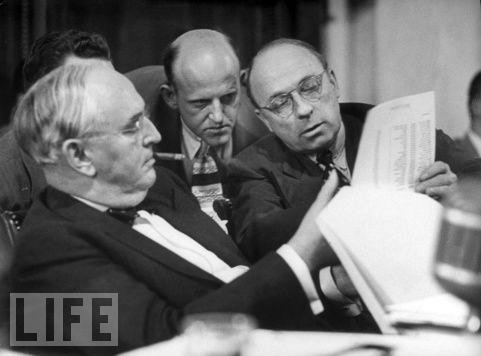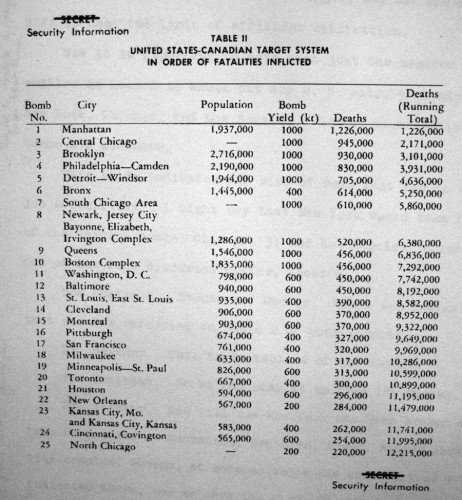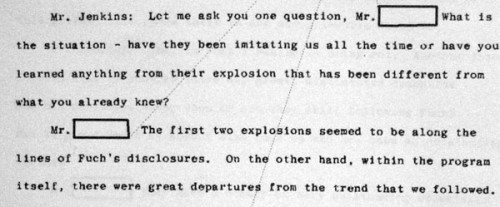A few weeks ago, I spent some time at the Legislative Archives in downtown Washington, DC, looking at the files of the Joint Committee on Atomic Energy (JCAE). It was my first time over there since I had moved to the area; I had been there a few other times over the years, but it’s really quite different when you actually live in the same town as the archive. It’s a less hurried, less harried, and less targeted experience: you can take the time to really look at things you might otherwise not have time for. Case in point: I actually got to spend some time talking with one of the archivists there, Bill Davis, who knows about the JCAE records. And last Thursday, Bill called me up to tell me that a new batch of newly-declassified JCAE Executive Hearings had arrived. How’s that for helpful? Of course I couldn’t resist, and swung by last Friday on my way to work.

JCAE members Sen. Vandenberg (l) and Sen. Hickenlooper (r) look over various documents at a 1949 hearing regarding the AEC.
The eight newly-declassified JCAE hearings are all from 1953, ranging from March to December. NARA isn’t in charge of declassifying them — these ones seem to have been declassified by someone at the CIA who is apparently just working his way through the decades-old queue. I imagine some poor declassifier sitting there with a 100 foot pile of paper next to him. In reality, these appear to have been scanned and are redacted using what looks like Adobe Acrobat. But it is just a single fellow doing it, apparently — his name (Alan Lipton) is on every one of them as the declassifier.
1953 was an important year. For one thing, the Cold War was pretty hot right about then. The Korean War was still going on for most of it; the US had tested a hydrogen bomb prototype, but not an actual usable weapon; the Soviets set off a “thermonuclear weapon” (not Teller-Ulam, but still not very nice) that August; McCarthyism was still going strong. Tough times.
So what are in these files? Here are a few notes from them — they cover some interesting topics. Many of them deal with CIA in particular, which is of some inherent interest.
- There’s a March 24, 1953 session where the JCAE met with the head of the Atomic Energy Commission, Gordon Dean, to talk about the development of power-producing reactors. It also segues into weapons topics, because of the questions about the use of HEU in fuels, or the production of heat rather than plutonium. A nice exchange:
Mr. Dean: “…the small amount [of HEU] that you would divert [from the military program] in the course of the next few years, all you can ‘crystal ball’ in this business, seems to me such that it gives the military very little problems. I think actually when the facts were understood the Department of Defense would probably encourage it.”
Rep. Durham: “They are not projecting their point of view except on a yearly basis at the present time, are they? One year at a time?”
Mr. Dean: “One year at a time, yes, sir; they have no five-year plan.”
Rep. Durham: “‘At the end of 1958 we are going to have plenty weapons and do not want any more.’ They have not said that to you?”
Mr. Dean: “No. They have indicates the stockpile of weapons they will reach in 1960 is as of today a minimum stockpile to do the job.”
Sen. Bricker: “What is the job?”
Mr. Dean: “In the event of total war in which everybody were throwing them around. They call it a minimum stockpile that they would like to have today.”
Rep. Cole: “Even assuming that you had the process of using this material for industrial purposes, you could not use it because it would be needed for defense purposes.”
Mr. Dean: “I think this is unrealistic actually because that figure they give us is not magic, obviously.”
Rep. Durham: “Will that not depend to a large extent on the knowledge we have as to the supply in case world conditions remain the same, as to what the other fellow [the USSR] is doing, how much he is producing?”
Mr. Dean: “When you get up into the numbers you are talking about in 1959 and 1960, I do not think it makes much difference what he is producing at that point.“
- One last little exchange from that transcript of relevance to nuclear power:
Sen. Bricker: “What about the effect upon the atmosphere of this private utilization in your reactors? Can that be guarded against?”
Dr. Hafstad: “No effect; nothing to worry about there.”
Mr. Lane: “All of these reactors have a completely closed system and keep everything in.”
Dr. Hafstad: “There is minor concern about accidents.”
Sen. Bricker: “About what?”
Mr. Dean: “Accidents like a pile blow-up. You have to have some sort of provision for perhaps vetoing the location of one of these at a given site; have to have some safety criteria. But I do not visualize much difference than regulations you have in civil aeronautics, something of that kind.”
- In a hearing from April 21, 1953, the Allen Dulles, H.M. Chadwell, and Herbert I. Miller (all CIA) met with the JCAE to discuss the status of the Soviet nuclear program. It’s a fascinating hearing, in part because even though the Soviets had detonated their first nuclear weapon all the way back in 1949, the Congressmen still needed some heavy convincing that the Soviets were capable of producing sophisticated nuclear weapons.
Senator Millikin: “It has been suggested that they [the USSR] have the energy [?], they know something about it, they have had explosions, but they do not have a weapon. This is what I am driving at.”
Mr. Miller: “That I think we can explain quite readily. Mr. Dulles has given the answer in part. [large deleted section]
Senator Millikin: “Could it be done without putting it in a ballistic case and making a weapon out of it?”
Mr. Miller: “Yes sir, but –”
Senator Millkin: “Your large assumption there is that the degree of skill would permit the making of a weapon?”
Mr. Miller: “That is right.”
Senator Millikin: “I might be able to make a shot gun and not make a revolver. I am not sure that there is not a little gap in the logic there.”
Mr. Miller: “Let’s turn it around the other way. In addition, the data [deleted] is most consistent — in fact, in our way of reading that data, it is not only consistent with an air drop, which is a weapon.” [Some discussion follows about how you can tell a ground drop from an air drop based on the fallout.]
Senator Millikin: “Would you say it is impossible for them to make these explosions without having a weapon drop?”
Mr. Miller: “No, sir. One tests a device. One need not test a weapon. One need only test a fission mechanism.”
Mr. Dulles: “I think I might add, Senator, it is almost impossible, I believe, to conceive that they would have the skill to do one and not the skill to do the other if they wanted to, and we assume from our other knowledge of the Soviets, if they could make a weapon, they would make a weapon.” […]
Senator Millikin: “I continue to speculate with the idea, they might have a weapon, that it might not be a feasible weapon for ordinary use, and that that might have some relation to the fact that they have not produced more explosions.” [They had earlier puzzled over the fact that the USSR had only tested three weapons by that point.]
- In another hearing, from May 5, 1953, the JCAE discussed the status of the DOD’s guided missile program. A nice little exchange between Rep. Patterson and K.T. Keller of the DOD Guided Missiles Division: Rep. Patterson: “What becomes of that projectile when it comes up?” Mr. Killer: “It will turn and come down.” Naturally so. The JCAE also took the time to quiz them, as they did a few time in the 1950s, about reports of “flying saucers”:
Sen. Hickenlooper: “Let me ask you this, Mr. Keller, or General Nichols: What do we know about Russian experiments in these various things that fly around? Have we found out there is anything to the flying saucers or any other flying things?”
Mr. Keller: “I haven’t run into any flying saucers anywhere.”
Sen. Hickenlooper: “How do we account for all of these reports by allegedly sane and trained individuals that talk about them?”
Mr. Keller: “I can account for one. I have a friend who is in the copper business and out in the West where one of his mines is located [and] his boys got all disturbed because they went back up and prospected further in the mountains and they came acrose some wreckage of what he thought sure was a flying saucer. He thought 1t might be of great interest to us, and he got photographs taken and the exact location and all of that dope on the thing. [sic] It didn’t take the boys more than 15 minutes to recognize what it was, it was a bomb, and the place where it was was right on a direct practice flight run and a plane evidently had gotten into trouble you see and had to jettison its bombs, a practice bomb, filled with sand.” [JCAE then turns to other matters without comment on this]
- Hickenlooper later in the hearing comes back to “this flying saucer business,” with more or less the same question. Keller says he doesn’t have a clue, but discounts them since the saucers would need fuel sources unlike anything they knew about: “If it is flying it has to get gasoline somewhere or some kind of fuel, and we don’t know any place where any of them ever stopped and fuel.” He also points out that whomever makes them (if they existed) must be doing better than the automobile industry since they never seem to break down. Rep. Price suggests that perhaps “they have got a space island somewhere.” Keller suggests that would be “a tremendous piece of mechanical development,” discounting it. Hickenlooper agrees with Keller but says he recalls the “old story of the Irishman that saw the elephant for the first time, and he said, ‘I still say that there is no such animal.'” Hickenlooper keeps wondering if they are real. Keller just says he doesn’t have any idea, and that “I am a kind of realistic guy, and I have got enough to do looking after trying to get these guided missiles out of the hands of the long hairs and get it into the hands of the guy in greasy overalls that I haven’t got time to fool with these other problems, you see.” General Nichols agrees that they seem to have accounted for most of the supposed phenomena.
- In a hearing from May 12, 1953, Dr. Lloyd Berkner, known for his role in the creation of the DEW line, talked to the JCAE about “civil defense,” which in this context actually meant the importance of early warning systems for any possibility of civil defense. It’s a long hearing, but what stands out to me are the slides the Berkner presented the JCAE, detailing the apparent order that they imagined a hypothetical 25 bomb attack would take against the United States and Canada, in order of fatalities:
- Berkner pointed out that “Of course, the H-bomb can be bigger [than on the chart], but the one-megaton size is near the limit of efficient utilization.” There’s also a nice graph in there which has “megadeaths” as one of its axis labels. Nice.
- On August 21, 1953, the JCAE met with the CIA again. This time it was with Lt. Gen. P. Cabell, USAF, and Acting Director, and a Mr. “Blank,” whose name was redacted from the transcript:
- Mr. Blank was apparently the CIA specialist on atomic energy matters. It’s an extremely rare thing, in my experience, to have a friendly witness’s name be blanked out like this in JCAE executive sessions, especially when so much of the content of what he had to say is printable. Very curious. His name appears to be 6 characters long, which is unfortunately quite common. He’s apparently someone who testified before the JCAE numerous times before (references are made to his “numerous appearances”). It’s tempting to suggest that it’s just Herbert Miller, again. (His name is redacted from the first page of the testimony he listed above, but not from the subsequent testimony. I was able to pinpoint which “Mr. Miller” it was from another memo in the file.) But I don’t really know. Anyway, the most interesting part of the testimony, other than that, is that it concerns the detonation of the first Soviet thermonuclear device, “Joe 4,” which caused quite a flurry. A lot of the technical detail is blanked out, but it’s pretty clear at parts that they are discussing the fact that though it used thermonuclear reactions, it was not the same magnitude of explosion as the Ivy Mike device. There’s also some shockingly displays of ignorance by some (non-prominent) members of the JCAE — one of them had to be instructed what “kilotons” and “megatons” referred to!
- Lastly, there is a hearing from December 11, 1953, where the JCAE had an executive session in Miamisburg, Ohio, at the site of Mound Laboratory. Mound produced initiators at this time. Of note from this meeting, is that apparently before 1950 it cost $18,000 (1953 prices) per initiator. In 1950 they dropped it down to $1,500. Now, depending on how you measure it, that means that it was costing from $120K to $689K per initiator initially (in 2010 prices), and they dropped it to between $10.3K and $57.4K. That’s tremendously expensive! At least, it seems that way to me. I have no idea what an initiator ought to cost, but half a million or so per initiator? And these were at a time when the initiators were made out of polonium, which had to be replaced after awhile anyway. Now they don’t go into how they calculated these prices, and presumably this is related to labor costs as well as material costs, but still, wow! One last thing to note: an AEC classification expert sat in on the meeting, and noted that “Mound Laboratory is a production plant of the Atomic Energy Commission which has always been referred to as a ‘laboratory’ for security reasons.” I thought that was pretty interesting, to be so bold about how false the name was. Said AEC expert would occasionally interject when the exuberant Mound scientists would get too excited about explaining how their new initiators worked: “In my capacity as security advisor, could I suggest he [the scientist] limit himself in this field as much as possible. … You are going a little strong.”
I was a bit later than usual in posting this today because I spent the morning watching Joshua Pollack speak at the Carnegie Endowment for International Peace. Josh went over his argument, presented recently in that fine journal of scholarly work, Playboy, that A.Q. Khan’s “fourth customer” (after Iran, North Korea, and Libya) was, in fact, India. Pretty fascinating stuff, and Josh did a great job of laying out the evidence. Read more about it at ACW. (I’d link to the article directly, but it’s blocked by AIP’s firewall!)




